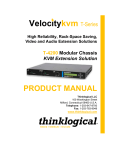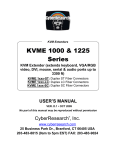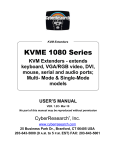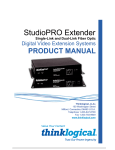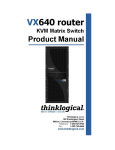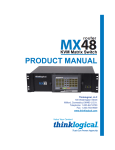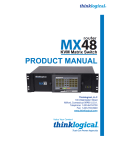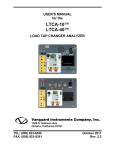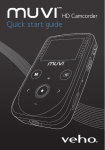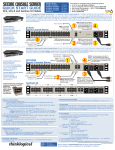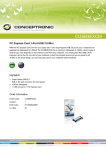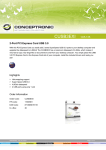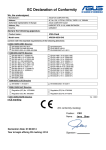Download Velocityrgb System-12 User Manual
Transcript
Copyright Notice Copyright © 2012. All rights reserved. Printed in the U.S.A. Thinklogical® LLC 100 Washington Street Milford, Connecticut 06460 U.S.A. Telephone: 1-203-647-8700 All trademarks and service marks are property of their respective owners. Subject: VelocityRGB Video Extension System-9, -10 and -12 Revision: D, December 2012 Revision D i December 2012 Table of Contents PREFACE............................................................................................................................................... iv Conventions Used in this Manual .........................................................................................................iv 1 Introduction ....................................................................................................................................... 1 1.1 Product Overview ......................................................................................................................... 1 1.2 Contents ....................................................................................................................................... 1 1.3 Laser Information ......................................................................................................................... 1 1.4 Theory of Operation ..................................................................................................................... 2 MRTS Technology ........................................................................................................................... 2 2 System Features ................................................................................................................................ 3 2.1 General System Features ............................................................................................................. 3 2.2 Basic Operation ............................................................................................................................ 3 2.3 Technical Specifications ............................................................................................................... 5 3 Connecting to the Velocity Extenders.............................................................................................. 6 3.1 Pluggable SFP+ ........................................................................................................................... 6 3.2 Fiber Optic Cable ......................................................................................................................... 7 Requirements ................................................................................................................................... 7 Handling Fiber Optic Cable .............................................................................................................. 7 Installing Fiber into Input/Output Cards ............................................................................................ 7 Removing Fiber from Input/Output Cards ......................................................................................... 7 The CPU and the TX Connector ....................................................................................................... 8 Modifying the Analog RGB Video Parameters .................................................................................. 8 3.3 Transmitter and Receiver ......................................................................................................... 9 3.4 AC Power Supply ..................................................................................................................... 10 4 Set-Up and Installation .................................................................................................................... 10 4.1 Order of Installation Events ........................................................................................................ 10 4.2 Firmware Upgrades .................................................................................................................... 10 4.2 Front Panel Usage ........................................................................................................................... 10 4.2.1 General Front Panel Usage..................................................................................................... 11 4.2.2 Saving Changes………………………………………………………………………………………….15 4.2.3 Restoring Factory Defaults ........................................................................................................ 16 Load factory default video configurations. .......................................................................................... 16 4.2.4 Naming the Transmitter Unit...................................................................................................... 17 4.2.5 Modifying an Existing Video Modeline ....................................................................................... 18 Modification to support the alternate timing. ....................................................................................... 18 5 Regulatory & Safety Compliance.................................................................................................... 22 5.1 Safety Requirements .................................................................................................................. 22 Symbols found on the product ........................................................................................................ 22 Regulatory Compliance .................................................................................................................. 22 North America ................................................................................................................................ 22 Australia & New Zealand ................................................................................................................ 22 European Union ............................................................................................................................. 22 5.2 Standards with Which Our Products Comply .............................................................................. 23 5.3 Supplementary Information ........................................................................................................ 23 Product Serial Number ................................................................................................................... 24 Connection to the Product .............................................................................................................. 24 Revision D ii December 2012 6 How to Contact Us ........................................................................................................................... 25 6.1 Customer Support ...................................................................................................................... 25 Website .......................................................................................................................................... 25 Email .............................................................................................................................................. 25 Telephone ...................................................................................................................................... 25 Fax ................................................................................................................................................. 26 6.2 Product Support ......................................................................................................................... 26 Warranty ........................................................................................................................................ 26 Return Authorization....................................................................................................................... 26 Our Address ................................................................................................................................... 27 APPENDIX A: ORDERING INFORMATION .......................................................................................... 28 APPENDIX B: QUICK START GUIDE .................................................................................................. 30 Revision D iii December 2012 PREFACE Conventions Used in this Manual Throughout this manual you will notice certain conventions that bring your attention to important information. These are Notes and Warnings. Examples are shown below. Note: Important Notes appear in blue text preceded by a yellow exclamation point symbol, like this. A note is meant to call the reader’s attention to helpful information at a point in the text that is relevant to the subject being discussed. Warning! All Warnings appear in red text, followed by blue text, and preceded by a red stop sign, like this. A warning is meant to call the reader’s attention to critical information at a point in the text that is relevant to the subject being discussed. Revision D iv December 2012 1 Introduction 1.1 Product Overview Industry standard RGB video formats up to 165 MHz are supported over multi-mode or single-mode fiber. Resolutions which fit into the 165 MHZ bandwidth will be flawlessly transported from end to end. The Velocity RGB-9 harnesses advanced fiber optic technology which means that image quality is not compromised with problems such as frame dropping or content loss. The VelocityRGB-12 product allows for component video. Each system consists of a transmitter and a receiver connected by multi-mode or single mode fiber optic cable. The transmitter unit connects to an analog video source with a suitable cable and the receiver unit provides connections to the display device. A +5V DC power supply is required on both the transmitter and receiver. The Velocity RGB-9 and Velocity RGB-12 require two fibers. The Velocity RGB-9 transmitter supports RGB video formats up to 165MHz. In addition, the Velocity RGB-9 has a local RGB video display port on the transmitter and is compatible with all Thinklogical Velocity fiber video receivers, whether RGB or DVI. The receiver converts the video signal back from optical to RGB formats. The Velocity RGB-9 receiver with dual RGB outputs is offered for distributing the video source to two displays, eliminating the need for an external distribution amp. 1.2 Contents When you receive your Thinklogical™ VelocityRGB Video Extender, you should find the following items: • • • • • RGB Video Extender Transmitter RGB Video Extender Receiver HD15M to HD15M cable, 2M (CBL000020-002MR) Universal AC Power adapters (PWR-000022-R) CD Product Manual 1.3 Laser Information The VelocityRGB Video Extender is designed and identified as Class 1 LASER products. Revision D 1 December 2012 1.4 Theory of Operation MRTS Technology Thinklogical® VelocityRGB Extenders utilize breakthrough, patent-pending technology for transmission and reception of DVI, keyboard, mouse, and high-speed data peripherals. This technology, known as Multi Rate Transmission System (MRTS), provides end-to-end data transmission with unparalleled performance. This new, unique optic platform enables multiple data streams to be transmitted long distances over single or multiple fibers with complete reconstruction of the data clock at the destination end point. The result is perfect synchronization with each transmitted stream. MRTS is a highly reliable technology and delivers powerful benefits to our customers when combined with our new SFP+ optics. The new MRTS Technology has the ability to transport every frame of a 1920 x 1200 @ 60Hz (or higher) video stream with no compression, along with all desktop peripherals (keyboard, mouse, etc., including 480Mbps USB 2.0) with no perceptible latency. Moreover, these signals can be transmitted distances from just a few meters up to 40 kilometers over single-mode or multi-mode fibers. MRTS allows for traditional AV implementations and video routing to be incorporated into the same switch fabric, providing greater value, flexibility, performance and security. Additional unique capabilities include the ability to support 6.25Gbps bandwidth per stream, between 50% and 100% higher than our nearest competitors (typically 1.485Gbps to 3.2Gbps). This is significant because a single DVI stream requires a 5.4Gbps data rate to accommodate the 165MHz of video data. Our competitor’s lower bandwidth capability is generally manifested in either dropped frames or lower resolution associated with compressing schemes. Not so with MRTS Technology. Revision D 2 December 2012 2 System Features 2.1 General System Features The RGB Video Extender is designed for high resolution video extension applications. Each RGB Video Extender system includes the following common features: • All copper cabling is industry standard • Units are stand alone and rack mountable (brackets included) • Local RGB Display port on transmitter • RGB supported to 1600 x 1200, 1920x1080 • Front LCD with user adjustable settings • Flawless image quality, with no frame dropping • Small package • Standard VGA (HD15) Copper Connectors • Supports Component Video (Velocity 12)- 1920x1080i, 480P, 720P • Velocity 12 TX Converts YPbPr component video into 4:4:4 RGB colorspace • Multi Mode Fiber extends video up to 1000m (type OM4 fiber) • Single Mode Fiber extends video up to 10km 2.2 Basic Operation The Velocity-9 Transmitter connects to the Receiver using fiber optic cables. The source computer connects to the Transmitter and the viewing and audio devices to the Receiver, as shown below. See the Quick Start Guide on page 29 for more details. Revision D 3 December 2012 Revision D 4 December 2012 2.3 Technical Specifications Storage Temperature -20 to 70 o C (-4 to 158 o F), 10 to 90% RH, non-condensing Power Consumption Transmitter: <15 Watts, typical Receiver: <15 Watts, typical Front Panel Display Transmitter and Receiver: 2 x 24 Liquid Crystal Display Copper Cables (Supplied with system) Velocity 9 TX Qty 1 CBL000020-002MR HD15 (M) to HD15 (M) Cable, 2M Velocity 10 TX Qty 1 CBL000013-002MR DVI(M) to DVI(M) Cable, 2M Velocity 12 TX Qty 1 CBL000020-002MR HD15 (M) to HD15 (M) Cable, 2M Qty 2 CBL000041 6FT VGA/HD15 to 3-RCA COMPONENT Single Mode or Multi Mode, depending upon model Up to 65 meters with Type OM1 Up to 350 meters with Type OM2 Up to 650 meters with Type OM3 Up to 1000 meters with Type OM4 Velocity 9 Height: 1.19” (3.016cm) Depth: 10” (25.4cm) Width: 6.49” (16.5cm) Weight: <1lb (0.45kg) Each Shipping Weight: 4lbs (1.81kg) Pair Velocity 10 Height: 1.19” (3.016cm) Depth: 10” (25.4cm) Width: 6.49” (16.5cm) Weight: <1lb (0.45kg) Each Shipping Weight: 4lbs (1.81kg) Pair Velocity 12 Height: 1.19 inches (3.016 cm) Depth: 10 inches (25.4 cm) Width: 6.49 inches (16.5 cm) Weight: <1 lb (0.45 kg) each Shipping Weight: 4 lbs (1.81 kg) (one Velocityrgb System-12 transmitter and one Velocity receiver) (Tolerance: ± .039"; .1000 mm) Optical Cable Optical Distance Dimensions Operating Temp and Humidity 0° to 50°C (32° to 122 °F), 5% to 95% RH, non-conde nsing Supply Voltage AC/DC Adapter Universal Input 90-264 VAC Compliance Approvals for US, Canada, and European Union (pending) 12 months from date of shipment. Extended warranties available. Warranty Revision D 5 December 2012 Connecting to the Thinklogical RGB Extender All physical connections to the product use industry-standard connectors. Non-supplied cables that may be needed are commercially available. All connections are found on the rear of the unit. 3.1 Pluggable SFP+ The SFP+ Optical Module is an 8Gbs Short-Wavelength Transceiver designed for use in bi-directional Fiber Optic Channel links. The modules are hot-pluggable and operate with 3.3VDC. Always use dust caps to protect against damage when a fiber optic connector is not attached to its coupling device (fiber optic equipment, bulkheads, etc.) Dust Plug Figure 11: SFP+ Module; it is good practice to install dust plugs in unused SFP+s Each SFP+ module is locked into its enclosure with a built-in latch handle that can be opened for removal or locked for installation. Figure 12a: SFP+ latch closed Figure 12b: SFP+ latch open The latch handle spans the two LC ports and arrows printed on the handle indicate which port is an INPUT ( ) and which is an OUTPUT ( ). Revision D 6 December 2012 3.2 Fiber Optic Cable Requirements Thinklogical recommends SX+ Laser Enhanced (50µm) fiber for your Velocity Extension System. Multimode fiber has the ability to extend up to a maximum of 1000m, where Single-mode fiber has the ability to extend distances beyond 1000m. Fiber optic cable must run between the location of the Transmitter unit (near your CPU) and the Receiver unit (near your desktop devices). The standard multi-mode fiber optic cable must be 50 micron, terminated with an SC, ST or LC type fiber optic connector and no longer than 3280 running feet (1000 meters). Be careful not to kink or pinch the fiber optic cable as it is being installed, and keep all bend radii to no less than 3 inches (76.2mm). Please refer to the Quick Start Guide included in Appendix B. Handling Fiber Optic Cable Unlike copper cabling, fiber optic cable requires special handling. A small speck of dust or a scratch to the ferrule tip (the end of the connector) can attenuate the optical signal so that it becomes unusable. Warning! The ends of the connectors (the ferrule) should never come in contact with any foreign object, including fingertips. Warning! Minimum bend radius must be 1.5”. Be careful not to pinch the fiber when using ties. 3.3 RGB Video Extender Transmitter If a DVI-A connection from the source is required, standard adapters are available from Thinklogical and third party suppliers to make other combinations. (See Table 3) FIGURE 7: Velocity RGB-9 Transmitter The CPU and the TX Connector Video connections to the CPU are made between the video output card of the CPU and the TX VGA connector labeled “FROM CPU” (closest to fiber connectors). The additional video connector is for a Revision D 7 December 2012 local administrator to view the video output at the TX unit. The analog VGA inputs are converted to a fiber optic suitable form and transmitted to the RX unit. Modifying the Analog RGB Video Parameters It is possible for one resolution to have different video timings, which could cause a less than perfect display on the remote side. For example, take 1280x1024x60 Hz. The VESA standard has 1688 pixels in one line, whereas a SGI format has 1680 pixels. The transmitter lookup table is configured for the VESA standard, but can be easily modified to support the SGI format. (Refer to Section 7.2.6 for step by step instructions.) FIGURE 14 FIGURE 15 FIGURE 14: 1280x1024x60 on an SGI computer with the PLLDIV set at 1688 (default value). the columns. Notice FIGURE 15: 1280x1024x60 on an SGI computer with the PLLDIV modified to 1680. The below table lists supported analog (VGA) resolutions: Thinklogical™ Veloctiy supported resolutions Active Resolution Pixels 640 640 640 640 640 Revision D Lines 448 480 480 480 480 Total Lines Vertical Freq(Hz) Horizontal Freq(kHz) Pixel Clock Freq(MHz) 472 525 520 500 509 66 60 72 75 85 31.2 31.5 37.9 37.5 43.3 25 25.175 31.5 31.5 36 8 Video Standard Honeywell Industry Standard VESA VESA VESA December 2012 720 800 800 800 800 800 1024 1024 1024 1024 1280 1280 1280 1280 1280 1280 1280 1280 1280 1366 1400 1400 1400 1400 1440 1440 1600 1680 1920 1920 1920 400 600 600 600 600 600 768 768 768 768 720 720 800 1024 1024 1024 1024 1024 1024 768 1050 1050 1050 1050 900 900 1200 1050 1080 1080 1080 449 625 628 666 625 631 800 806 800 808 750 750 828 1066 1066 1082 1066 1072 1063 795 1090 1080 1089 1099 932 934 1250 1089 1125 1125 1125 70 56 60 72 75 85 50 60 75 85 50 60 60 50 60 60 75 85 96 60 50 60 60 96 60 60 60 60 25 50 60 31.5 35.1 37.9 48.1 46.9 53.7 40 48.4 60 68.7 37.5 45 49.7 52.8 64 64.8 80 91.1 102 47.7 54.5 64.8 65.3 105.4 55.8 55.9 75 65.3 28.12 56.25 67.5 28.32 36 40 50 49.5 56.25 53.44 65 78.75 94.5 74.25 74.25 83.46 89.55 108 108.88 135 157.5 163.277 85.5 94.61 120.78 121.75 164.5 106.4 106.5 162 146.25 74.25 148.5 148.5 Industry Standard VESA VESA VESA VESA VESA Folsom VESA VESA VESA Folsom CEA-861-E VESA GTF Folsom VESA Discreet VESA VESA SGI Onyx2 VESA GTF Folsom VESA CVT-RB VESA SGI Stereo VESA GTF VESA DMT VESA VESA DMT Folsom Folsom CEA-861-E Supported Analog VGA Resolutions *In the Velocity 12 product 480p, 720p and 1080i resolutions are supported at 60Hz. 3.3 RGB Video Extender Receiver The receiver connects to your display/monitor video Input using a VGA, HD15 (if monitor has a VGA/HD15 connector). These cables are provided with unit. Standard adapters are available from Thinklogical and third party suppliers if necessary to make other connections. Revision D 9 December 2012 FIGURE 22: Velocity RGB-9 Receiver 3.4 AC Power AC Power Supply Two power supply adapters (part number PWR-000022-R) are included. Universal Input: 100 – 240 VAC 50/60Hz Nominal Continuous Short Circuit Protection Over Voltage Protection Optional AC adaptors to fit various international standards AC Power Supply (PN: PWR-000022-R) shown with international AC adaptors 4 Set-Up and Installation 4.1 Order of Installation Events Please refer to the Quick Start Guide included with your products for detailed instructions. The Quick Start Guide is also available in Appendix A. 4.2 Firmware Upgrades Firmware upgrades are available from Thinklogical. Please call us for technical assistance at (203) 6478700. 4.2 Front Panel Usage Revision D 10 December 2012 LCD Navigation Pad enter Powered by MRTS Technology Velocityrgb Video Extension System - 9 Receiver LCD System Information and Programming FIGURE 28: VelocityRGB Video Extension System – 9, LCD DISPLAY 4.2.1 General Front Panel Usage Once the unit is powered up, the initial display is shown as follows: Thinklogical Velocity TX9 vxx.xx This displays the device type and revision of the base unit. By pressing the arrow (down) keys, the RGB Video Extender allows you to enter into the main menu. All main root menu items are displayed with an *. They are as follows: *System Revision D 11 December 2012 *DDC *Video *Enable Component. Video YES Once an * root menu item is displayed, you can then use the (left) or (right) arrow keys to review settings or make changes, if allowed. The RGB Video Extender menu functionality is as follows: Revision D 12 December 2012 Some menu options may not be available on some models Display Modifiable *System LS Connected TX Ctrl Name Load Defaults Store Values TX Control RX Control FPGA Version Serial Number Aud Reset En SFP Loss of Signal channel. Value = Description NO TX Only YES YES NO NO NO YES YES NO An indication of the fiber status from the TX to RX. Name entered on TX unit is displayed on RX unit. Loads factory default video configurations. Store video configurations. Revision of the TX control firmware. Revision of the RX control firmware. Revision of the FPGA code Serial Number of unit. Resets the audio sync circuitry An indication of fiber status on the extender Receive 0 if signal is received, 1 if signal is missing. Debug Values YES Factory Use Only. ___________________________________________________________________________________________ ______________ *DDC – To be implemented at a later date DDC PROM Emula. Mode YES Options are Dynamic, Static and Passthru. In Dynamic mode, the DDC of the monitor connected to the RX is read and stored on the TX. The CPU is informed of a change in DDC and the monitor is read. This is useful when the CPU can be turned on without a connection to the RX. Static mode is used to maintain the current DDC regardless of monitor changes at the RX. Pass-thru acts as a wire between the TX and RX and no emulation takes place. Load Default DDC mode to YES Loads the default EDID table into the TX and changes the Acquire DDC stores it Static. Gets the EDID table from the monitor attached to the RX and YES Force DDC mode digital. YES in the TX. Sets the EDID Video Input Signal Type to either analog or * Video VGA Connected Resolution input Hor. Freq Auto Phase PLL Total No No No Yes Yes An indication of whether VGA video is input to the Vis TX Active pixels x active lines vertical rate Horizontal frequency Automatically adjust the Sampling Phase to the best setting The total pixel count in one line. Consists of Horizontal active pixels + HSOUT Width DE Start DE Width Line Start measured Yes Yes Yes Yes Horizontal blanking pixels Horizontal sync (Hsync) of video, measured in pixels Horizontal back porch (Hpb) of video, measured in pixels Total active pixels in one line Vertical back porch (Vbp) + Vertical sync (Vsync) of video, in lines Revision D 13 December 2012 Line Width NativeH Use Yes No NativeV input. Use the No ISL Sync Status NO ISL Sync Activity Video 1 cnt Video 2 cnt Enable Component Video No No Revision D The number of visible lines For use by Tech support to determine horizontal frequency input. NO Yes the following formula to calculate the frequency: NativeH * 16 For use by Tech support to determine vertical frequency following formula to calculate the frequency: (10,000,000/NativeV)/16 For use by Thinklogical support. Measures sync selection and sync polarity For use by Thinklogical support. Measures sync activity Internal use only. Internal use only. Enables component video resolutions 14 December 2012 4.2.2 Saving Changes Save video configurations so that after powering up, the device can recall customer video settings. Thinklogical VelocityTX9 vxx.xx Using the down arrow, scroll down to *System as shown below. *System Using the right arrow, scroll right until Store Values is displayed as shown below then press enter. Store Values Yes/No= NO Using the up arrow or down arrow scroll until Yes appears as shown below. Then press enter. Revision D 15 December 2012 Store Values Yes/No = YES Using the right arrow or left arrow, scroll until you return to the *System menu option. Using up arrow or down arrow, scroll until you get back to the Thinklogical screen. 4.2.3 Restoring Factory Defaults Load factory default video configurations. Using the down arrow, scroll down to *System as shown below. *System Using the right arrow button, scroll right until Load Defaults is displayed as shown below. Then press enter. Load Defaults Yes/No= NO Using the up arrow or down arrow scroll until Yes appears as shown below. Then press enter. Revision D 16 December 2012 Load Defaults Yes/No= YES Follow the steps in Section 4.3.2 Saving Changes to save your changes. 4.2.4 Naming the Transmitter Unit Modify the name of the unit through the Transmitter. The name entered on the Transmitter will display on the Receiver unit. Using the arrow down button, scroll down to *System as shown below. *System Using the right arrow, scroll right until Tx Ctrl is displayed as shown below. Then press enter. Tx Ctrl Name= Revision D TXUnit01 17 December 2012 Using the right or left arrow, scroll until the blinking cursor is under the letter/number you want to change. Tx Ctrl Name= TXUnit01 Using the up or down arrow, scroll (holding down the up or down arrow will scroll faster) until you find the appropriate letter/number. Then press enter. Tx Ctrl Name= TXUnit11 Using the right or left arrow, scroll to return to the *System menu option. *System Follow the steps in Section 2.7.2 Saving Changes to save your changes. The steps are listed below: 1. Using the down arrow, scroll down to *System as shown below. 2. Using the right arrow, scroll right until Store Values is displayed as shown below. Then press enter. 3. Using the up or down arrow scroll until Yes appears as shown below. Then press enter. 4. Using the right or left arrow, scroll to return to the *System menu option. 5. Using up or down arrow scroll until you get to the Thinklogical screen. 4.2.5 Modifying an Existing Video Modeline Modification to support the alternate timing. Revision D 18 December 2012 Example of modifying an existing video modeline: The VESA timing for 1280x1024_60Hz (SXGA) is loaded into the VelocityRGB 9 TX. The modeline can be easily modified to support the alternate timing listed in the table below. Modifiable differences are highlighted. Parameter Supported Timing Resolution Pixel Clock (MHz) Horizontal Frequency (kHz) Vertical Refresh (Hz) Horizontal Total Pixels Horizontal Active (Pixels) Horizontal Front Porch(Pixels) Horizontal Sync Width(Pixels) Horizontal Back Porch(Pixels) Vertical Total Lines (Lines) Vertical active lines (Lines) Vertical Front Porch (Lines) Vertical sync (Lines) Vertical Back Porch (Lines) 1280x1024_60 108 63.98 60 1688 1280 48 112 248 1066 1024 1 3 38 Alternate Timing 1280x1024_60 SGI Onyx 107.352 63.9 60 1680 1280 40 120 240 1065 1024 3 3 35 Thinklogical VelocityTX9 Vxx.xx The resolution you wish to modify must be applied to the TX video input connector. Using the arrow down, scroll down to *Video as shown below. *Video Using the right arrow, scroll right until VGA Connected is displayed as shown below. Then press enter. Revision D 19 December 2012 PLL Total 1688 The Horizontal Pixel needs to be changed to 1680 to reflect the Alternate Timing listed on Table 4. Move the cursor under the number you want to change by pressing the right or left arrow. Use the arrow up or down to increment or decrement the number. Once number is entered correctly, press enter. Using the right arrow, scroll right until DE Start is displayed as shown below. Then press enter. DE Start 248 The Horizontal Backporch (Pixels) needs to be changed to 240 to reflect the Alternate Timing listed on Table 4. Move the cursor under the number you want to change by pressing the right or left arrow. Use the arrow up or down to increment or decrement the number. Once number is entered correctly, press enter. Using the right arrow, scroll right until Line Start is displayed as shown below. Then press enter. The Vertical Backporch (Pixels) needs to be changed to 35 to reflect the Alternate Timing listed on Table 4. Move the cursor under the number you want to change by pressing the right or left arrow. Use the arrow up or down to increment or decrement the number. Once number is entered correctly, press enter. Using the right or left arrow, scroll to return to *Video menu option. Revision D 20 December 2012 *Video Follow the steps in Section 2.7.2 Saving Changes to save your changes. The steps are listed below: 1. 2. 3. 4. 5. 6. 7. Revision D Using the down arrow, scroll down to *System as shown below. Using the right arrow, scroll right until Store Values is displayed as shown below. Then press enter. Using the up or down arrow scroll until Yes appears as shown below. Then press enter. Using the right or left arrow, scroll to return to the *System menu option. Using up or down arrow scroll until you get to the Thinklogical screen. 21 December 2012 5 Regulatory & Safety Compliance 5.1 Safety Requirements Symbols found on the product Markings and labels on the product follow industry-standard conventions. Regulatory markings found on the products comply with domestic and many international requirements. Regulatory Compliance Thinklogical®’s Velocity Extension System is designed and made in the U.S.A. The Velocity Extension system has been tested by a certified testing laboratory and found to be compliant with the following standards (both domestic USA and many international locations): North America Safety ANSI/UL60950-1: 1st Edition (2003) CAN/CSA C22.2 No. 60950-1-03 LASER Safety CDRH 21CFR 1040.10 Class 1 LASER Product Electromagnetic Interference FCC CFR47, Part 15, Class A Industry Canada ICES-003 Issue 2, Revision 1 Australia & New Zealand This is a Class A product. In a domestic environment this product may cause radio interference, in which case the user may be required to take adequate measures. European Union Declaration of Conformity Manufacturer’s Name & Address: Thinklogical® 100 Washington Street Milford, Connecticut 06460 USA Telephone 1-203-647-8700 These products comply with the requirements of the Low Voltage Directive 72/23/EEC and the EMC Directive 89/336/EEC. Revision D 22 December 2012 5.2 Standards with Which Our Products Comply Safety CENELEC EN 60950-1, 1st Edition (2001) LASER Safety IEC60825:2001 Parts 1 and 2 Class 1 LASER Product Electromagnetic Emissions EN55022: 1994 (IEC/CSPIR22: 1993) EN61000-3-2/A14: 2000 EN61000-3-3: 1994 Electromagnetic Immunity EN55024: 1998 Information Technology Equipment-Immunity Characteristics EN61000-4-2: 1995 Electro-Static Discharge Test EN61000-4-3: 1996 Radiated Immunity Field Test EN61000-4-4: 1995 Electrical Fast Transient Test EN61000-4-5: 1995 Power Supply Surge Test EN61000-4-6: 1996 Conducted Immunity Test EN61000-4-8: 1993 Magnetic Field Test EN61000-4-11: 1994 Voltage Dips & Interrupts Test 5.3 Supplementary Information The following statements may be appropriate for certain geographical regions and might not apply to your location. This Class A digital apparatus meets all requirements of the Canadian Interference-Causing Equipment Regulations. Cet appareil numérique de la classe A respecte toutes les exigencies du Règlement sur le matérial brouilleur du Canada. Warning! This is a Class A product. In a domestic environment, this product may cause radio interference, in which case the user may be required to take corrective measures. Revision D 23 December 2012 Note: This equipment has been tested and found to comply with the limits for a Class A digital device, pursuant to part 15 of the FCC Rules. These limits are designed to provide reasonable protection against harmful interference when the equipment is operated in a commercial environment. This equipment generates, uses and can radiate radio frequency energy and, if not installed and used in accordance with the instruction manual, may cause harmful interference to radio communications in which case the user may be required to take adequate corrective measures at their own expense. Note: This Class A digital apparatus complies with Canadian ICES-003 and has been verified as being compliant within the Class A limits of the FCC Radio Frequency Device Rules (FCC Title 47, Part 15, Subpart B CLASS A), measured to CISPR 22: 1993 limits and methods of measurement of Radio Disturbance Characteristics of Information Technology Equipment. Note: The user may notice degraded audio performance in the presence of electromagnetic fields. Note: If using a keyboard that is noise susceptible, a ferrite ring on the keyboard cable may be needed to comply with Immunity Requirements Product Serial Number Thinklogical® products have a unique serial number, imprinted on an adhesive label that is fixed to the bottom of the chassis. The serial number includes a date-code. The format for the date-code is 2 digits for the month, 2 digits for the day and 2 digits for the year, plus two or three digits for a unique unit number. This serial number is also found on the original shipping carton. Connection to the Product Connections and installation hardware for our products use industry-standard devices and methods. All wiring connections to the customer equipment are designed to minimize proprietary or customized connectors and cabling. Power connections are made with regionally appropriate power cords and approved methods. Revision D 24 December 2012 6 How to Contact Us 6.1 Customer Support Thank you for choosing a Thinklogical® product for your application. We appreciate your business and are dedicated to helping you successfully use our product. Thinklogical® is here to help you. Thinklogical® is an engineering company and you will receive the information you require directly from our most knowledgeable engineers. We believe that the first line of support is the design engineer that developed the product. Therefore, your questions will be handled promptly by our in-house engineers who are most familiar with your products. To contact Thinklogical®, use the following telephone numbers and internet-based methods. Website Check out our website for current product offerings, support information and general information about all of the products we offer. Our internet website offers product information on all current systems, including technical specification sheets and installation guides (for viewing online or for download), product diagrams showing physical connections and other information you might need. Internet: www.thinklogical.com Note: Most online documents are stored as Adobe Acrobat “PDF” files. If you do not have the Adobe Acrobat reader needed to view PDF files, visit www.adobe.com for a download. Email Thinklogical® is staffed Monday through Friday from 8:30am to 5:00pm, Eastern Time Zone. We will try to respond to your email inquiries promptly, use the following email addresses for your different needs: [email protected] – Information on Thinklogical® and our products. [email protected] – Sales Department - orders, questions or issues. [email protected] – Product support, technical issues or questions, product repairs and request for Return Authorization. Telephone Telephone Sales: Contact our expert sales staff via telephone in Milford, CT at 1-203-647-8700 or if in the continental US, you may use our toll-free number 1-800-291-3211. We are here Monday through Friday from 8:30am to 5:00pm, Eastern Time Zone. Ask for your representative’s direct dial phone number when you call. Revision D 25 December 2012 Telephone Product Support: Contact Product Support via telephone in Milford, CT at 1-203-647-8700. The support lines are manned Monday through Friday, 8:30am to 5:00pm, Eastern Time Zone. International Sales: Please contact our US sales staff in Milford, CT at 1-203-647-8700. We are here Monday through Friday, 8:30am to 5:00pm, Eastern Time Zone (same as New York City). If leaving a voice message please provide a “best time to call back” so we may reach you at your convenience. Our switchboard attendant will direct your call during regular business hours. We have an automated attendant answering our main telephone switchboard after regular business hours and holidays. You can leave voice messages for individuals at any time. Our Sales Representatives have direct numbers to speed up your next call to us. Fax Our company facsimile number is 1-203-783-9949. Please indicate the nature of the fax on your cover sheet and provide return contact information. 6.2 Product Support Thinklogical’s® support personnel are available Monday through Friday from 8:30am to 5:00pm, Eastern Time Zone. If your application requires assistance at some time outside of our normal business hours, please contact us beforehand and we will do our best to make arrangements to help you with your Thinklogical® products. Warranty Thinklogical® warrants this product against defects in materials and workmanship for a period of one year from the date of delivery. Thinklogical® and its suppliers disclaim any and all other warranties. Note: Thinklogical® Inc. products carry a one year warranty, with longer term available at time of purchase on most products. Please refer to your product invoice for your products Warranty Terms & Conditions. Defect remedy shall be the repair or replacement of the product, provided that the defective product is returned to the authorized dealer within a year from the date of delivery. If you wish to return your device, contact the Thinklogical® authorized dealer where you purchased the device, or if you purchased directly, call Thinklogical® at 1-800-291-3211 (USA). Return Authorization In the event you must return a product to Thinklogical® directly, please contact Customer Support at 1-800-291-3211 or 1-203-647-8700. Customer Support will ask you to describe the problem and will issue you a Return Merchandise Authorization number (RMA#). Pack the device in its original box, if possible, and return it with the RMA# printed on the outside of the box. Revision D 26 December 2012 Note: DO NOT return a product to Thinklogical® without a Return Material Authorization. Return address for products with Return Material Authorization: Thinklogical®, LLC Attn: RMA# 100 Washington Street Milford, CT 06460 USA PH: 1-800-291-3211 (USA only) Our Address If you have any issue with a product, have product questions or need technical assistance with your Thinklogical® system, please call us at 1-800-291-3211 (USA only) or 1-203-647-8700 and let us help. If you’d like to write us, our mailing address is: Thinklogical® LLC. 100 Washington Street Milford, CT 06460 USA Revision D 27 December 2012 APPENDIX A: ORDERING INFORMATION Thinklogical's VelocityRGB Extenders Part Number Description Velocity 9 Part Numbers VEL-AV0M09-LCRX Velocity 9 RGB RX, RGB HV, AUX VGA Output, Serial, Audio, MM, LC VEL-AV0M09-LCTX Velocity 9 RGB TX, RGB HV, Local Display, Local VGA Port, Serial, Audio, MM, LC VEL-AV0M09-LCRA Velocity 9 RGB RX, RGB HV, AUX VGA Output, Serial, Separate Audio, MM, LC VEL-AV0M09-LCTA Velocity 9 RGB TX, RGB HV, Local Display, Local VGA Port, Serial, Separate Audio, MM, LC VEL-AVRM09-LCRX Velocity 9 RGB RX, RGB HV, AUX VGA Output, Serial, Audio, Redund Optics, MM, LC VEL-AVRM09-LCTX Velocity 9 RGB TX, RGB HV, Local Display, Local VGA Port, Serial, Audio, Redund Optics, MM, LC VEL-AV0X09-LCRX Velocity 9 RGB RX, RGB HV, AUX VGA Output, Serial, Audio, Multipath, MM, LC VEL-AV0X09-LCTX Velocity 9 RGB TX, RGB HV, Local Display, Local VGA Port, Serial, Audio, Multipath, MM, LC VEL-AV0M12-LCTX Velocity 12 RGB TX, RGB HV, Local Display/VGA Port, Component, Serial, Audio, MM, LC VEL-AV0M12-LCTA Velocity 12 RGB TX, RGB HV, Local Display/VGA Port, Component, Serial, Separate Audio, MM, LC Velocity 12 RGB TX, RGB HV, Local Display/VGA Port, Component, Serial, Audio, Redund Optics, MM, LC Velocity 12 RGB TX, RGB HV, Local Display/VGA Port, Component, Serial, Audio, Multipath, MM, LC Velocity 10 Part Numbers VEL-AVRM12-LCTX VEL-AV0X12-LCTX Velocity 9/12 Optics, Multi-Mode VOP-M04 Velocity 9/12 Optics Option for TX/RX, MM, Dual Fiber, 1000M, LC VOP-M01 Velocity 9/12 Optics Option for TX/RX, MM, Dual Fiber, 1000M, SC/ST VOP-M26 Velocity 9/12 Redund Optics Option for TX/RX, MM, Four Fibers, 1000M, LC VOP-M22 Velocity 9/12 Redund Optics Option for TX/RX, MM, Four Fibers, 1000M, SC/ST VOP-S11 Velocity 9/12 Optics Option for TX/RX, SM, Dual Fiber, 10KM, LC VOP-S05 Velocity 9/12 Optics Option for TX/RX, SM, Dual Fiber, 10KM, SC/ST VOP-S41 Velocity 9/12 Redund Optics Option for TX/RX, SM, Four Fibers, 10KM, LC VOP-S15 Velocity 9/12 Redund Optics Option for TX/RX, SM, Four Fibers, 10KM, SC/ST VOP-S41 Velocity 9/12 with Separate Audio Optics Option for TX/RX, SM, Four Fibers, 10KM, LC VOP-S15 Velocity 9/12 with Separate Audio Optics Option for TX/RX, SM, Four Fibers, 10KM, SC/ST VOP-S12 Velocity 9/12 Multipath Optics Option for TX/RX, SM, Three Fibers, 4KM, LC VOP-S08 Velocity 9/12 Multipath Optics Option for TX/RX, SM, Three Fibers, 4KM, SC/ST VEL-AV0M10-LCRX Velocity 10 RGB RX, RGB HV, DVI-I, AUX VGA Output, Serial, Audio, MM, LC VEL-AV0M10-LCTX Velocity 10 RGB TX, RGB HV, DVI-I, Local Display, Local VGA Port, Serial, Audio, MM, LC VEL-AV0M10-LCRA Velocity 10 RGB RX, RGB HV, DVI-I, AUX VGA Output, Serial, Separate Audio, MM, LC VEL-AV0M10-LCTA Velocity 10 RGB TX, RGB HV, DVI-I, Local Display, Local VGA Port, Serial, Separate Audio, MM, LC VEL-AVRM10-LCRX VEL-AV0X10-LCRX Velocity 10 RGB RX, RGB HV, DVI-I, AUX VGA Output, Serial, Audio, Redund Optics, MM, LC Velocity 10 RGB TX, RGB HV, DVI-I, Local Display, Local VGA Port, Serial, Audio, Redund Optics, MM, LC Velocity 10 RGB RX, RGB HV, DVI-I, AUX VGA Output, Serial, Audio, Multipath, MM, LC VEL-AV0X10-LCTX Velocity 10 RGB TX, RGB HV, DVI-I, Local Display, Local VGA Port, Serial, Audio, Multipath, MM, LC Velocity 9/12 Optics, Single-Mode Velocity 10 Part Numbers VEL-AVRM10-LCTX Revision D 28 December 2012 Velocity 10 Optics, Multi-Mode VOP-M19 Velocity 10 Optics Option for TX/RX, MM, Dual Fiber, LC, SC or ST, 1000M VOP-M30 Velocity 10 Redund Optics Option for TX/RX, MM, Four Fibers, LC, SC or ST, 1000M VOP-M14 Velocity 10 with Separate Audio Optics Option for TX/RX, MM, Four Fibers, LC, SC or ST, 1000M VOP-M21 Velocity 10 Multipath Optics Option for TX/RX, MM, Three Fibers, LC, SC or ST, 1000M Velocity 10 Optics, Single-Mode VOP-S04 Velocity 10 Optics Option for TX/RX, SM, Dual Fiber, LC, SC or ST, 10KM VOP-S06 Velocity 10 Redund Optics Option for TX/RX, SM, Four Fibers, LC, SC or ST, 10KM VOP-S89 Velocity 10 Redund Optics Option for TX/RX, SM, Four Fibers, LC, SC or ST, 40KM VOP-S06 Velocity 10 with Separate Audio Optics Option for TX/RX, SM, Four Fibers, LC, SC or ST, 10KM VOP-S06 Velocity 10 Multipath Optics Option for TX/RX, SM, Three Fibers, LC, SC or ST, 4KM VOP-S58 Velocity 10 Multipath Optics Option for TX/RX, SM, Three Fibers, LC, SC or ST, 40KM Revision D 29 December 2012 APPENDIX B: QUICK START GUIDE VelocityRGB-9 Quick Start Guide Revision D 30 December 2012 VelocityRGB-10 Quick Start Guide Revision D 31 December 2012 VelocityRGB-12 Quick Start Guide Revision D 32 December 2012






































